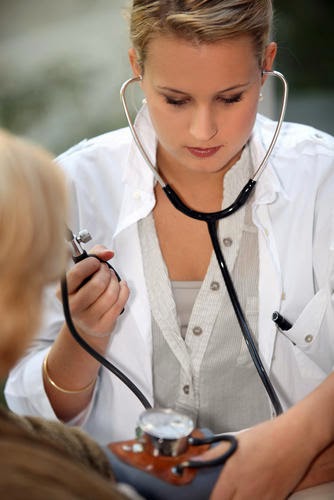Natural Way To Control The Blood Pressure+What is Best Of BP Patients Foods?
Natural Ways to Reduce Your BP
Lifestyle changes can shrink your risk of high blood pressure by a whopping 78 percent, research shows, even if you have a family history.
Lose weight: Extra pounds are the top predictor of high blood pressure in women, says a 2009 Harvard study.
The more you weigh, the more blood your body needs to supply oxygen and nutrients to your tissues. This increases the volume of blood circulating through your blood vessels, which boosts pressure on your artery walls. Getting to a healthy weight, meaning a BMI under 25, cuts your risk of high blood pressure by 40 percent. (If you're 5-foot-4 and 140 pounds or less, that puts you in the healthy zone.) Not even medication affects blood pressure as much as losing weight. For every 20 pounds you trim, you can drop blood pressure by up to 20 points.
Get moving:
Doing 30 minutes of vigorous exercise every day can make a big difference. After all, your heart is a muscle. The more you work out, the more efficiently it pumps blood, which keeps vessels flexible.
Eat smart:
The DASH (Dietary Approaches to Stop Hypertension) diet can significantly reduce blood pressure in as little as two weeks. This eating plan is low in sodium and rich in fruits, vegetables, nuts, and legumes. It also recommends low-fat dairy products, whole grains, and nutrients that help control blood pressure, like potassium, calcium, magnesium, and fiber.
Cook more:
Help shake your salt habit by cooking more whole foods at home and avoiding the drive-through. Check labels of canned, frozen, and packaged foods and pick ones that are the lowest in sodium. When you cook, use flavorful herbs and spices or a squeeze of lemon or lime instead of reaching for the salt shaker.
Calm your stress:
Juggling your career, your family, and your social life can make you feel frazzled. When you're stressed your body produces a surge of hormones, like adrenaline and cortisol, which helps you conquer deadlines. But this may also cause a temporary spike in blood pressure by making your heart beat faster and your blood vessels narrow. Relaxation techniques like deep breathing and meditation can help reduce the pressure.
Log enough sleep:
Getting less than six hours of sleep a night dramatically increases the risk of high blood pressure, especially in the childbearing years, according to a 2010 study in the Journal of Hypertension. Sleep keeps stress hormones in check and helps your nervous system remain healthy by recharging your batteries.
Hypertension and Pregnancy
Up to 8 percent of pregnant women get hypertension, which can be extremely dangerous for mom and baby. It's increasing as women are getting heavier and having babies later.
Gestational hypertension, which usually develops after the 20th week of pregnancy, can cause premature delivery and puts you at risk for stroke or cardiac arrest. It also makes you more likely to develop heart or kidney disease later in life. It's usually controlled with medication or by delivering the baby.
Preeclampsia, a more serious condition that can happen if you're over 40 or carrying twins or triplets, prevents the placenta from getting enough blood, depriving the fetus of oxygen and vital nutrients. Besides premature delivery, it can lead to rupture of your liver, kidney failure, hemorrhage, stroke, or even death. The only cure is delivery.
BP Tips
Sodium Shocker
Sodium can really add up over the course of your day. It's not hard to imagine eating these three meals, which deliver more than three times the recommended daily sodium intake of 1,500 milligrams.
Breakfast
2 slices whole wheat toast with jam: 307mg
2 slices bacon: 370mg
2 large eggs: 358mg
Dinner
Spaghetti and Meatballs
1 cup spaghetti: 325mg
1/2 cup marinara sauce: 527mg
4 meatballs, made with seasoned bread crumbs: 743mg
Salad
2 tablespoons low-fat ranch dressing: 330mg
Lunch
Turkey Sandwich
2 slices deli turkey: 508mg
1 slice provolone cheese: 249mg
2 slices whole wheat bread: 292mg
1 tablespoon light mayo: 78mg
1 teaspoon mustard: 57mg
1 cup minestrone: 698mg
How Low Should You Go?
Blood pressure is expressed as a ratio.
Systolic, the top number, is the pressure in your blood vessels while your heart contracts to pump blood to your body.
Diastolic, the lower number, represents the pressure when your heart relaxes between beats.
If your blood pressure is 90/60 to 119/79, that's considered normal. If you're 120/80 to 130/89, that's called pre-hypertensive and you should be monitored carefully. Once you hit 140/90, you officially have hypertension and need treatment.
You can add years to your life by reducing your blood pressure. Current guidelines say 120/80 is optimal, but many experts believe 115/75 is even better. You should aim for 115/75, says Dr. Roizen. That's backed up by the results of a landmark study involving more than 20 million people in 52 countries. "The good news is that we can get almost everyone to 115/75 now using a combination of lifestyle changes and medication," he says.

Labels
Health tips


Post A Comment
No comments :